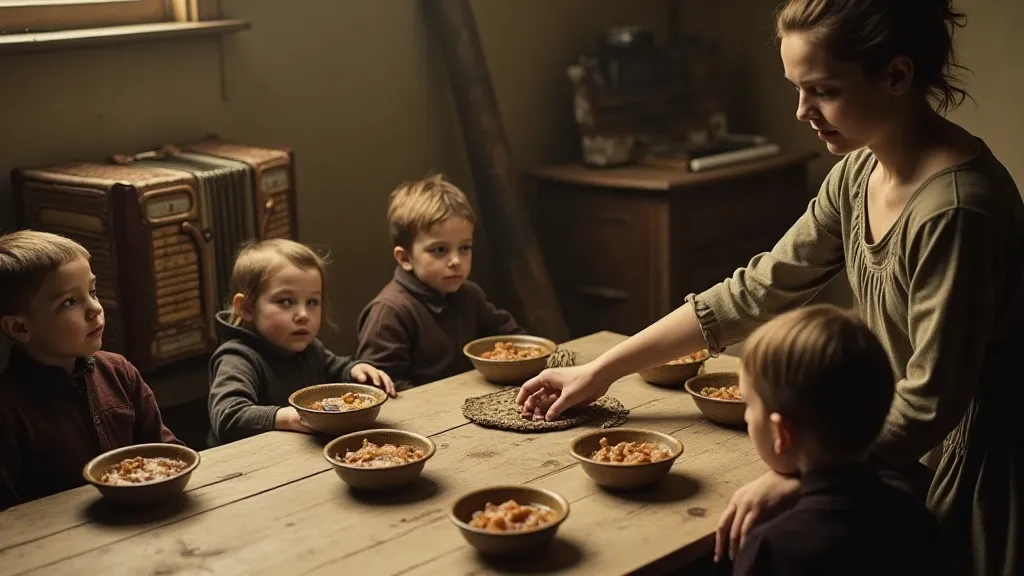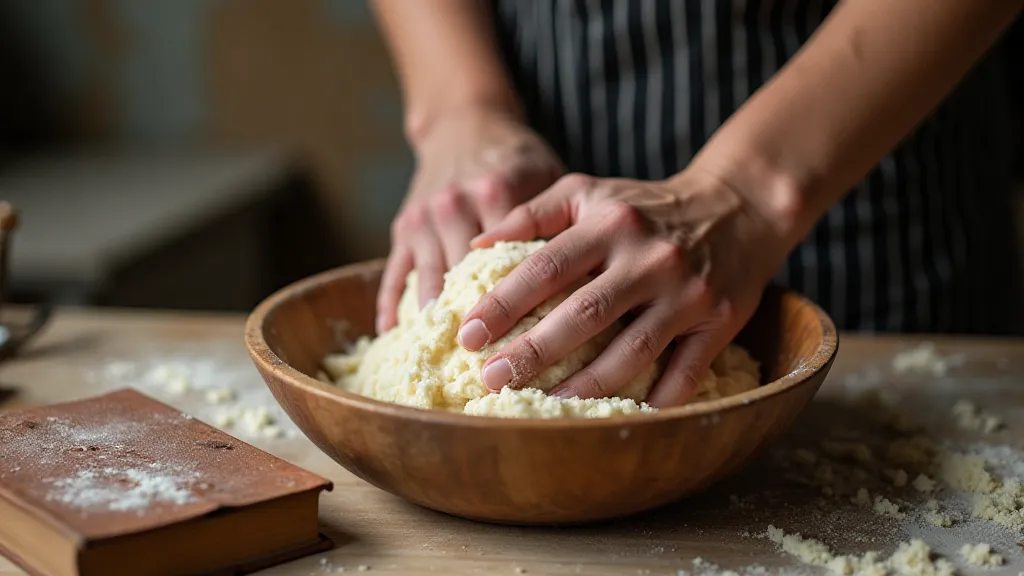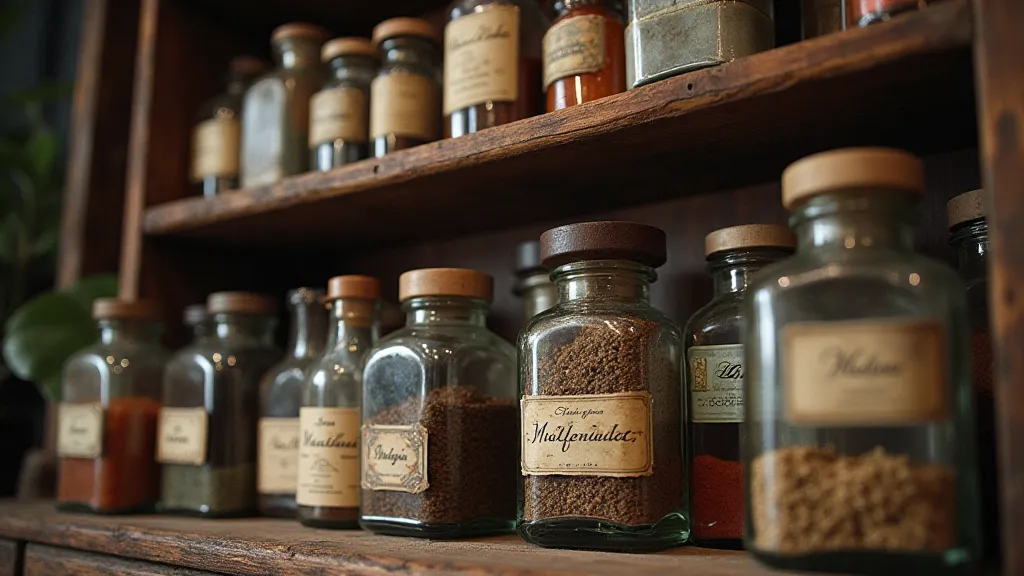The Silent Supper: Echoes of Shared Absence in Vintage Fare
The Great Depression. The very name conjures images of breadlines, dust bowls, and stark economic hardship. But beyond the statistics and the historical accounts lies a quieter, more profound reality – the daily lives of families striving to maintain normalcy, hope, and a sense of connection in the face of overwhelming loss. The meals they prepared weren’t merely sustenance; they were carefully orchestrated rituals, laden with unspoken grief and resilient hope. They were silent suppers, echoing with the absence of loved ones, lost opportunities, and a future that felt perpetually out of reach. They were, in a profound sense, performances of resilience played out around the family table.
Consider the accordion, often associated with lively gatherings and celebratory music. Imagine a Depression-era family, perhaps a father or grandfather, playing a worn, beloved accordion, its bellows sighing with a melancholic tune. It wasn's a sound of unadulterated joy; it was a balm against despair, a temporary reprieve from the gnawing anxieties that permeated every aspect of their lives. Just as the accordion held both potential for merriment and the weight of shared sadness, so too did the meals they ate.

The Semiotics of the Table: More Than Just Food
The Depression wasn's just about scarcity of ingredients; it was about the carefully constructed performance of normalcy. The table setting, even with chipped enamel plates and threadbare napkins, became a symbolic act of defiance against despair. To gather around the table, to share a meal, was to reaffirm the bonds of family, to demonstrate a continuation of tradition, and to hold onto the belief that things would eventually improve. The ritual itself offered a fleeting sense of stability in a world that felt increasingly chaotic. Families often stretched their resources, innovating with simple, readily available ingredients to create meals that offered a small measure of comfort and a sense of shared experience. For many, a humble breakfast of cornmeal mush was a daily reminder of resourcefulness and perseverance.
Think about the significance of a shared pitcher of water. With sugar and other luxuries scarce, water often became the centerpiece of the beverage offering. It wasn't just about hydration; it was a tangible symbol of sharing, of finding joy in the simplest pleasures, and of communal solidarity. Even the positioning of chairs – the deliberate arrangement of loved ones around the table – communicated a silent narrative of connection and support.
The Ingredients of Resilience: Frugality and Flavor
The recipes themselves speak volumes about the resourcefulness and ingenuity of the era. Flour, cornmeal, potatoes, beans, and inexpensive cuts of meat were the foundations of countless meals. These ingredients weren’s considered “lesser” at the time; they were staples – the building blocks of survival. Recipes like Creamed Chipped Beef, Hoppin' John, and Potato Bread are not just culinary instructions; they's testaments to a generation's ability to create flavorful, nourishing meals from seemingly meager resources. The challenge wasn’t merely about filling stomachs; it was about transforming basic ingredients into dishes that offered a sense of normalcy and even a hint of pleasure amidst hardship. Many families relied on recipes that could be adapted based on what was available, reflecting the flexibility and creativity born out of necessity. For a quick and easy option, many turned to chipped beef on toast.
The emphasis was on “nose-to-tail” cooking – utilizing every part of the animal to minimize waste. Leftovers were transformed into new dishes, stretching every scrap of food as far as possible. Lard, rendered from the animal fat, wasn's discarded; it became a vital cooking fat and a source of fuel for lamps. These weren't mere cost-saving measures; they were ingrained values, a profound respect for the food and the effort that went into obtaining it. Canning and preserving became essential skills, allowing families to extend the availability of seasonal produce long after the harvest was over. The ability to transform a simple potato into a delicious and versatile dish, like potato cakes, was a mark of resourcefulness and a source of pride.
The Craftsmanship of Simple Meals
Consider the handmade nature of so many aspects of Depression-era cooking. Many families grew their own vegetables, preserved fruits and vegetables through canning, and made their own bread and other staples. These weren't just about saving money; they were about connection – a tactile link to the land and to generations past. The skills passed down through families – the knack for making biscuits that practically floated, or the ability to coax flavor from the humblest of ingredients – became cherished legacies, tangible reminders of a richer past and a source of hope for the future. The knowledge of how to cultivate a small garden, even in the face of drought and dust storms, offered a sense of agency and a connection to the natural world.
The older generation imparted wisdom through their hands, shaping dough and stirring pots with a practiced ease. Younger generations learned not just the recipes but also the philosophy behind them: the importance of thrift, the value of community, and the power of perseverance. This craftsmanship wasn’t just about the final product; it was about the process, the connection to tradition, and the quiet satisfaction of creating something essential with one's own hands. Learning the art of preserving fruits and vegetables wasn't just about extending their shelf life; it was about carrying on a tradition that connected them to their ancestors and instilled a deep appreciation for the bounty of the land.

Passing Down the Legacy: More Than Just Recipes
The recipes of the Great Depression weren't simply handed down as instructions; they were shared as narratives, interwoven with stories of hardship, resilience, and love. The aroma of baking bread might evoke memories of a mother’s unwavering strength, while the taste of a simple bean soup might recall a father’s quiet determination. These weren’t just meals; they were conduits to a shared history, tangible links to a better time. The stories associated with these recipes often included lessons about resourcefulness, perseverance, and the importance of family – values that transcended the simple act of preparing a meal. They served as reminders of a time when ingenuity and resilience were essential for survival.
The act of cooking became a form of storytelling, a way of transmitting values and preserving memories. Children learned not just how to prepare the dishes but also the significance of the ingredients, the stories behind the recipes, and the importance of appreciating what they had. These weren’t just about survival; they were about preserving the spirit of a generation. Imagine a grandmother recounting the tale of how she and her siblings shared a single apple between them during a particularly lean year, emphasizing the importance of sharing and finding joy in the simplest of things.
A Silent Conversation Across Generations
Today, when we recreate these vintage recipes, we’s not just following instructions; we’s engaging in a silent conversation with those who came before us. We’s honoring their ingenuity, acknowledging their struggles, and appreciating the enduring power of community. We's tasting not just the flavors of the past but also the echoes of shared absence, the whispers of hope, and the silent strength of a generation that refused to be defeated. Understanding the context in which these meals were created—the scarcity, the hardship, the unwavering hope—deepens our appreciation for the resourcefulness and ingenuity of those who came before us. The landscape of the Dust Bowl, vividly captured in photographs and literature, profoundly shaped the lives of those who experienced it, and the meals they prepared reflected both the challenges and the resilience of that era.
The silent suppers of the Great Depression were more than just meals; they were acts of defiance, celebrations of resilience, and enduring testaments to the power of the human spirit. They remind us that even in the darkest of times, the simple act of sharing a meal can be a source of comfort, connection, and hope. Reflecting on the era, and recreating those simple, heartfelt dishes, provides a connection to a period of immense hardship and demonstrates the remarkable ability of the human spirit to persevere through adversity.

The stories surrounding these meals, often passed down through generations, underscore the deeper significance of these culinary traditions. They serve as reminders of a time when ingenuity and resilience were essential for survival, and they offer a powerful connection to the past.





